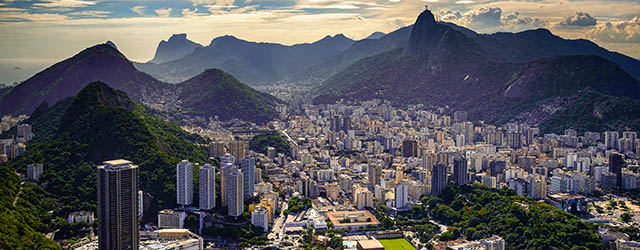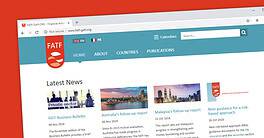Regional Report | The large economies on the east coast of Latin America—Brazil, Venezuela and Argentina—are slumping badly. Things are far different out west.

The oversupply of oil and other natural resources—and the surge in the value of the US dollar—have proved to constitute a double whammy for Latin America. The glut has pushed down prices. The decline has been made worse by the stronger greenback, the currency that is used to settle most oil trades. The plunge in commodities prices, in turn, has throttled a region that generates a good deal of revenue from the sale of natural resources. Indeed, following a decade of solid—sometimes spectacular—economic growth, Latin America has hit a very thorny patch. Or at least part of it has.
In reality, the picture is substantially different depending on which side of the continent you’re talking about, Most of the countries that face the Atlantic Ocean are doing poorly. Brazil, the region’s largest economy, is suffering its worst recession in 25 years. Only Venezuela, which has been on a downward slide for quite a while, is doing worse. Argentina is in the middle of a tepid recovery. Conversely, the Pacific-facing countries—mainly the four trading partners in the Pacific Alliance—are looking better. While each of the four nations (Peru, Columbia, Mexico and Chile) has lowered its GDP forecast, the countries remain on track for solid expansion. Peru and Colombia particularly stand out.
The relatively upbeat prospects for the Pacific Alliance nations, however, tend to get lost in the overall economic numbers for the region. Gross domestic production in Latin America and the Caribbean more than halved to 1.3% in 2014, down from 2.9% in 2013. For this year, the International Monetary Fund sees a further slowdown in economic output to 0.5%. Forecasts collected by survey firm Consensus Economics tell a bleaker tale. Latin America and the Caribbean could see flat growth in 2015.
Peru, on the other hand, is expected to generate a 3.1% hike in GDP growth in 2015. “It is difficult to put all countries in the same basket,” cautions Alonso Cervera, head of Latin American Economics at Credit Suisse. “I think that there are problem cases, there are success stories, and there are middle-of-the-pack countries. You have to look at each country independently, as opposed to drawing your own conclusion from GDP-weighted averages.”
“I think that there are problem cases, there are success stories, and there are middle- of-the-pack countries.”
~ Alonso Cervera, Credit Suisse
One thing that does apply to most of the countries in Latin America: The heady days of the commodities supercycle that jacked up the prices of natural resources in the early 2000s are gone.
“The region could pick up over the medium term,” says Edward Glossop, emerging markets economist at Capital Economics in London. “But it is going to remain weaker than the past decade of the commodities boom.”
HIGH INFLATION, LOW CONFIDENCE
Brazil remains by far the biggest worry in the region. The drop in commodities prices has been a big blow to the big country. A stubborn fiscal deficit hasn’t helped. Worse, the nation has been paralyzed by a deep political crisis. The unrest was triggered by allegations that legislators and political parties received kickbacks from state-owned oil giant Petrobras. The scandal has brought proceedings in Brasília, the nation’s capital, to a virtual halt, leading to a reduction in government spending. The situation has been inflamed by an inflation rate running at more than 9%—the highest level in Brazil in 12 years.
All have combined to slam the country’s economy. In a Consensus Economics report, more than 20 panelists predicted a 1.6% contraction in GDP for this year. The report noted, “Expectations have continued to slide amid further signs of weakness.” José Francisco de Lima Gonçalves, chief economist at Banco Fator in São Paulo, now believes GDP in Brazil will contract this year between 2.5% and 3.0%. He also expects the recession to spill over into 2016, at least for the first two quarters.
It could drag out longer. Fears that current president Dilma Rousseff will be impeached seem somewhat overblown, but the approval rating for the second-term president has plunged to 7%, sapping her political clout. “If anything,” Gonçalves warns, “there is a downside risk, and things can be even worse.”
|
July Survey |
Real GDP |
Consumer prices |
||||
|
2014 |
2015 |
2016 |
2014 |
2015 |
2016 |
|
|
Argentina |
0.5 |
0.5 |
1.3 |
24 |
17.2 |
25.6 |
|
Bolivia |
5.3 |
4.6 |
4.7 |
5.2 |
4.9 |
5.3 |
|
Brazil |
0.1 |
-1.6 |
0.6 |
6.4 |
8.9 |
5.5 |
|
Chile |
1.9 |
2.4 |
3 |
4.6 |
3.7 |
3.1 |
|
Colombia |
4.6 |
3.1 |
3.3 |
3.7 |
3.9 |
3.2 |
|
Costa Rica |
3.5 |
3 |
3.7 |
5.1 |
2.3 |
4.5 |
|
Dominican Republic |
7.3 |
5.1 |
4.7 |
1.6 |
1.7 |
3 |
|
Ecuador |
3.8 |
1.6 |
2.7 |
3.7 |
4.2 |
3.8 |
|
El Salvador |
2 |
2.3 |
2.3 |
0.5 |
1.2 |
2 |
|
Guatemala |
4.2 |
3.9 |
3.6 |
2.9 |
2.9 |
3.6 |
|
Honduras |
3.1 |
3.4 |
3.5 |
5.8 |
5.6 |
4.2 |
|
Mexico |
2.1 |
2.6 |
3.2 |
4.1 |
2.9 |
3.4 |
|
Nicaragua |
4.7 |
4.4 |
4.7 |
6.5 |
5.1 |
6.5 |
|
Panama |
6.2 |
6 |
6.1 |
2.6 |
2.1 |
2.8 |
|
Paraguay |
4.4 |
4 |
3.9 |
4.2 |
3.8 |
4.1 |
|
Peru |
2.4 |
3.1 |
4.2 |
3.2 |
3.3 |
2.8 |
|
Uruguay |
3.5 |
2.8 |
3.2 |
8.3 |
7.8 |
7.3 |
|
Venezuela |
-3 |
-6.4 |
-2.7 |
64.7 |
133.5 |
111.3 |
|
Latam |
1 |
0 |
1.5 |
13 |
20.3 |
17.5 |
|
Latam ex Venezuela |
1.5 |
0.7 |
2 |
7 |
7 |
6.5 |
A substantial slide in the value of the country’s currency could provide some relief, however. The real is down more than 50% against the US dollar this year. A weaker real makes the country’s exports cheaper, which should spark some life into the Brazilian economy, although the process could take years. “Some of our manufacturers have survived years of overvalued currency and now can recover some of the lost business,” Gonçalves notes. “There are a few signs that this is already happening. It could help to recover tax revenue and help the public fiscal deficit.”
Weakening currencies in most Latin American nations should boost exports for the region. Glossop at Capital Economics also points out that Latin America has a much lower level of external debt denominated in US dollar than in the past.
PACIFIC HEIGHTS

A sizable hike in exports would be a tonic for Brazil and the other large economies on the east coast of the continent. Out west, it would simply provide greater impetus to the ongoing recovery in the Pacific Rim nations. Peru and Chile are currently benefiting from accommodating fiscal and monetary policies. They also appear to be best positioned to overcome the shock from the falling commodities prices. One of those commodities—industrial metals—has actually seen a pickup in prices of late. Both Chile and Peru are big exporters of copper and other metals used in manufacturing.
According to Consensus Economics, Peru’s gross domestic product rate is expected to rise 4.2% in 2016. Chile, which will likely register GDP growth of 2.4% this year, is projected to see a 3% rise in output in 2016. Mexico is on a similar trajectory. The country’s Treasury department expects the value of goods and services produced this year to rise by around 2.4%. But gains from the opening of the country’s economy to foreign competition should kick in after a few years, particularly in the energy and telecommunications sectors. Some economists now expect Mexico’s GDP growth rate to rise steadily over the next few years, hitting 4% by 2018.
Colombia’s economy is also expanding at a solid pace. The country recorded a 4.6% GDP growth rate in 2014, according to the World Bank. This year, that number will be closer to 3.5%, the organization estimates. The drop is mostly owing to the plunge in the price of petroleum. Alejandro Grisanti, head of research and strategy for Latin America at Barclays Capital, worries that officials in Bogotá are not doing enough to compensate for the fall in oil revenues. But a massive government build-out of the country’s highway system—launched in 2014 by Colombian president Juan Manuel Santos and dubbed the Fourth Generation—is spurring investments in the country. When completed, the new roads should cut travel time between major cities by nearly half. In addition, the highways will drastically lower the cost of transporting goods between industrial zones in the Andes and major ports.
Such a network should prove to be a fillip for the Pacific Alliance members. The trade pact aims to hike business between the four nations by establishing a single market with no tariffs and no barriers to free trade. So far, the alliance is making strides, albeit slowly. Cervera of Credit Suisse notes that 10 years ago, fully 90% of Mexico’s trade was with the US. The percentage is closer to 80% now. A good deal of the decline stems from increased trade with nations in Asia, however. The Pacific Alliance could help Mexico reduce its reliance on trade with the US, although the trade arrangement is not going to have an immediate impact on the country. “Mexico should look more at its trade with southern countries,” said Barclay’s Grisanti. “It would be to the benefit of Mexico and to the benefit of the rest of the region.”
DEFAULT RISK
Farther east, the news keeps getting worse. In Argentina, investors are nervously monitoring a legal battle between the government and a group of American hedge funds over unpaid debt from the country’s 2002 default. A resolution to the dispute could reignite interest in Argentina and attract a new wave of foreign capital to the country. But restoring investor confidence is going to take time. GDP growth in Argentina will likely come in at a dismal 0.5% in 2015. Next year won’t be much better. Economists see a mere 1% rise in 2016.
Leaders in Venezuela would be thrilled by such an economic performance. A further fall in petroleum prices—which many economists are predicting—could once again rock the oil-rich nation. The country has already been gutted by the collapse of the cost of crude. Venezuela’s economy is expected to contract by a whopping 6.4% this year, and 2.7% next year, according to Consensus Economics. At the same time, consumer prices are likely to double.
The good news? The country is not expected to default on state debt in the coming months, nor the loans taken out by the state-owned oil giant PDVSA. But Barclays’ Grisanti says the real test will be a payment due in October 2016. To meet that deadline, Grisanti warns, things have to break Venezuela’s way. “Either oil prices recover,” he says, “or China will lend Venezuela more funds.”



